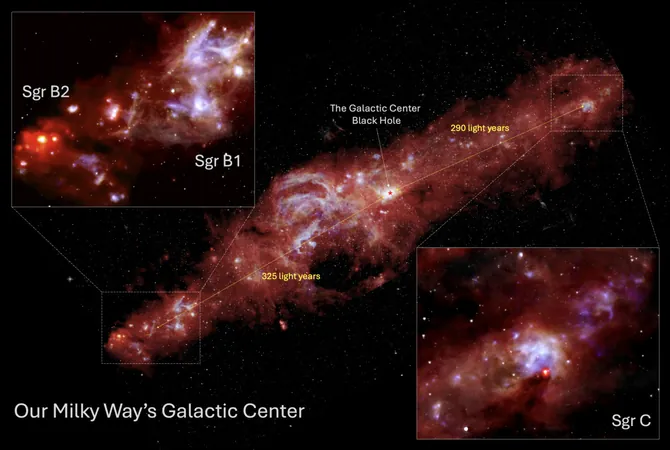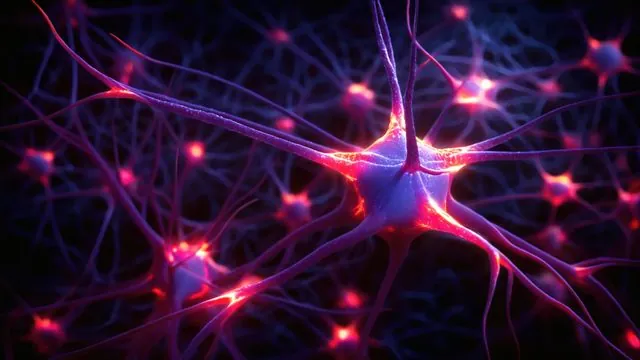
Mystifying Stellar Nurseries in Our Galactic Center Baffle Scientists
2025-06-09
Author: Yu
In a groundbreaking revelation, researchers from the SETI Institute and Caltech have discovered some puzzling truths about star formation at the heart of the Milky Way. Led by Dr. James De Buizer and Dr. Wanggi Lim, this research sheds light on why massive stars are forming at a surprisingly slow rate near the Galactic Center.
Star-Forming Regions Under Scrutiny
Using data from NASA's retired SOFIA airborne observatory, the scientists focused on three star-forming regions—Sgr B1, Sgr B2, and Sgr C—nestled in the dense heart of our galaxy. Contrary to expectations, these areas boast a higher density of the raw materials needed for star creation yet exhibit an astonishingly low output of high-mass stars compared to other regions of the Milky Way.
Is Star Formation on a Decline?
Dr. De Buizer pointed out, "Recent studies suggest that star formation is likely depressed near the Galactic Center, with some evidence indicating almost no current star formation. While we found that massive stars are being born, the rate is strikingly low." This research challenges long-held beliefs about these stellar nurseries, suggesting they may produce only a single generation of stars, unlike their more prolific counterparts.
Extreme Galactic Conditions to Blame?
The harsh and chaotic conditions around the supermassive black hole at the center of the galaxy could be stifling star formation. As gas clouds orbit the black hole, they may be disrupted by interactions with older stars or material spiraling inwards. This turbulence might prevent gas clouds from coalescing, thereby inhibiting the birth of new stars.
Sgr B2: A Glimmer of Hope?
Interestingly, Sgr B2 stands apart from the rest. Although its massive star formation rate is low, it retains a rich reservoir of gas and dust, hinting at a potential for future star clusters to emerge.
Challenging Conventional Wisdom
Historically, giant H II regions like Sgr B1 and Sgr C have been considered reliable homes for massive star clusters still forming from their parent clouds. However, this new study suggests they might not fit that mold, possibly representing a novel class of stellar nurseries.
The High-Resolution Breakthrough
Thanks to SOFIA's advanced infrared capabilities, the research team identified over sixty newly forming massive stars in the Galactic Center. Even so, these stellar formations fall short both in mass and quantity compared to similar regions in the galaxy.
Looking Ahead to New Discoveries
As Dr. Lim noted, "While these Galactic Center regions share similarities with their more tranquil counterparts elsewhere in the Milky Way, they notably lack the continuous production of stars we see in those areas. This study opens the door to further exploration and understanding of our galaxy's complex dynamics."
Keep an eye out for Dr. Lim's presentation on this intriguing research at the upcoming 246th meeting of the American Astronomical Society in Anchorage, Alaska.




 Brasil (PT)
Brasil (PT)
 Canada (EN)
Canada (EN)
 Chile (ES)
Chile (ES)
 Česko (CS)
Česko (CS)
 대한민국 (KO)
대한민국 (KO)
 España (ES)
España (ES)
 France (FR)
France (FR)
 Hong Kong (EN)
Hong Kong (EN)
 Italia (IT)
Italia (IT)
 日本 (JA)
日本 (JA)
 Magyarország (HU)
Magyarország (HU)
 Norge (NO)
Norge (NO)
 Polska (PL)
Polska (PL)
 Schweiz (DE)
Schweiz (DE)
 Singapore (EN)
Singapore (EN)
 Sverige (SV)
Sverige (SV)
 Suomi (FI)
Suomi (FI)
 Türkiye (TR)
Türkiye (TR)
 الإمارات العربية المتحدة (AR)
الإمارات العربية المتحدة (AR)